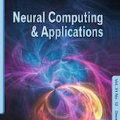Access to the proper infrastructure is critical when performing medical image segmentation with Deep Learning. This requirement makes it difficult to run state-of-the-art segmentation models in resource-constrained scenarios like primary care facilities in rural areas and during crises. The recently emerging field of Neural Cellular Automata (NCA) has shown that locally interacting one-cell models can achieve competitive results in tasks such as image generation or segmentations in low-resolution inputs. However, they are constrained by high VRAM requirements and the difficulty of reaching convergence for high-resolution images. To counteract these limitations we propose Med-NCA, an end-to-end NCA training pipeline for high-resolution image segmentation. Our method follows a two-step process. Global knowledge is first communicated between cells across the downscaled image. Following that, patch-based segmentation is performed. Our proposed Med-NCA outperforms the classic UNet by 2% and 3% Dice for hippocampus and prostate segmentation, respectively, while also being 500 times smaller. We also show that Med-NCA is by design invariant with respect to image scale, shape and translation, experiencing only slight performance degradation even with strong shifts; and is robust against MRI acquisition artefacts. Med-NCA enables high-resolution medical image segmentation even on a Raspberry Pi B+, arguably the smallest device able to run PyTorch and that can be powered by a standard power bank.
翻译:在与深层学习进行医学图像分割时,进入适当的基础设施至关重要。 这一要求使得很难在资源受限制的情景(如农村地区和危机期间的初级护理设施)中运行最先进的全方位分割模型。 最近出现的神经细胞自动自动模型(NCA)领域表明,本地互动的单细胞模型可以在图像生成或低分辨率投入中分解等任务中取得竞争性结果。 但是,它们受到高 VRAM要求和高分辨率图像趋同难度的制约。 为了克服这些限制,我们建议MD- NCA,即高分辨率图像分割的端到端NCA培训管道。我们的方法遵循一个两步进程。全球知识首先在低尺度图像的单元格之间进行交流。 之后,我们提议的MD- NCA可以在传统的图像生成或低分辨率分解中分别比传统的UNet高出2%和3% Dice,同时要小500倍。 我们还表明,MDNCA是设计不耐久的,甚至连惯性硬性PRA, 也只能通过高分辨率和高分辨率的图像转换。




